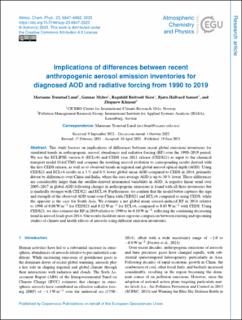| dc.contributor.author | Lund, Marianne Tronstad | |
| dc.contributor.author | Myhre, Gunnar | |
| dc.contributor.author | Skeie, Ragnhild Bieltvedt | |
| dc.contributor.author | Samset, Bjørn Hallvard | |
| dc.contributor.author | Klimont, Zbigniew | |
| dc.date.accessioned | 2024-03-05T11:25:29Z | |
| dc.date.available | 2024-03-05T11:25:29Z | |
| dc.date.created | 2023-07-27T10:58:52Z | |
| dc.date.issued | 2023 | |
| dc.identifier.citation | Atmospheric Chemistry and Physics (ACP). 2023, 23 (12), 6647-6662. | en_US |
| dc.identifier.issn | 1680-7316 | |
| dc.identifier.uri | https://hdl.handle.net/11250/3121073 | |
| dc.description.abstract | This study focuses on implications of differences between recent global emissions inventories for simulated trends in anthropogenic aerosol abundances and radiative forcing (RF) over the 1990–2019 period. We use the ECLIPSE version 6 (ECLv6) and CEDS year 2021 release (CEDS21) as input to the chemical transport model OsloCTM3 and compare the resulting aerosol evolution to corresponding results derived with the first CEDS release, as well as to observed trends in regional and global aerosol optical depth (AOD). Using CEDS21 and ECLv6 results in a 3 % and 6 % lower global mean AOD compared to CEDS in 2014, primarily driven by differences over China and India, where the area average AOD is up to 30 % lower. These differences are considerably larger than the satellite-derived interannual variability in AOD. A negative linear trend over 2005–2017 in global AOD following changes in anthropogenic emissions is found with all three inventories but is markedly stronger with CEDS21 and ECLv6. Furthermore, we confirm that the model better captures the sign and strength of the observed AOD trend over China with CEDS21 and ECLv6 compared to using CEDS, while the opposite is the case for South Asia. We estimate a net global mean aerosol-induced RF in 2014 relative to 1990 of 0.08 W m−2 for CEDS21 and 0.12 W m−2 for ECLv6, compared to 0.03 W m−2 with CEDS. Using CEDS21, we also estimate the RF in 2019 relative to 1990 to be 0.10 W m−2, reflecting the continuing decreasing trend in aerosol loads post-2014. Our results facilitate more rigorous comparison between existing and upcoming studies of climate and health effects of aerosols using different emission inventories. | en_US |
| dc.language.iso | eng | en_US |
| dc.publisher | Copernicus Publications | en_US |
| dc.rights | Navngivelse 4.0 Internasjonal | * |
| dc.rights.uri | http://creativecommons.org/licenses/by/4.0/deed.no | * |
| dc.title | Implications of differences between recent anthropogenic aerosol emission inventories for diagnosed AOD and radiative forcing from 1990 to 2019 | en_US |
| dc.title.alternative | Implications of differences between recent anthropogenic aerosol emission inventories for diagnosed AOD and radiative forcing from 1990 to 2019 | en_US |
| dc.type | Peer reviewed | en_US |
| dc.type | Journal article | en_US |
| dc.description.version | publishedVersion | en_US |
| dc.source.pagenumber | 6647-6662 | en_US |
| dc.source.volume | 23 | en_US |
| dc.source.journal | Atmospheric Chemistry and Physics (ACP) | en_US |
| dc.source.issue | 12 | en_US |
| dc.identifier.doi | 10.5194/acp-23-6647-2023 | |
| dc.identifier.cristin | 2163748 | |
| dc.relation.project | Norges forskningsråd: 314997 | en_US |
| cristin.ispublished | true | |
| cristin.fulltext | original | |
| cristin.qualitycode | 2 | |

